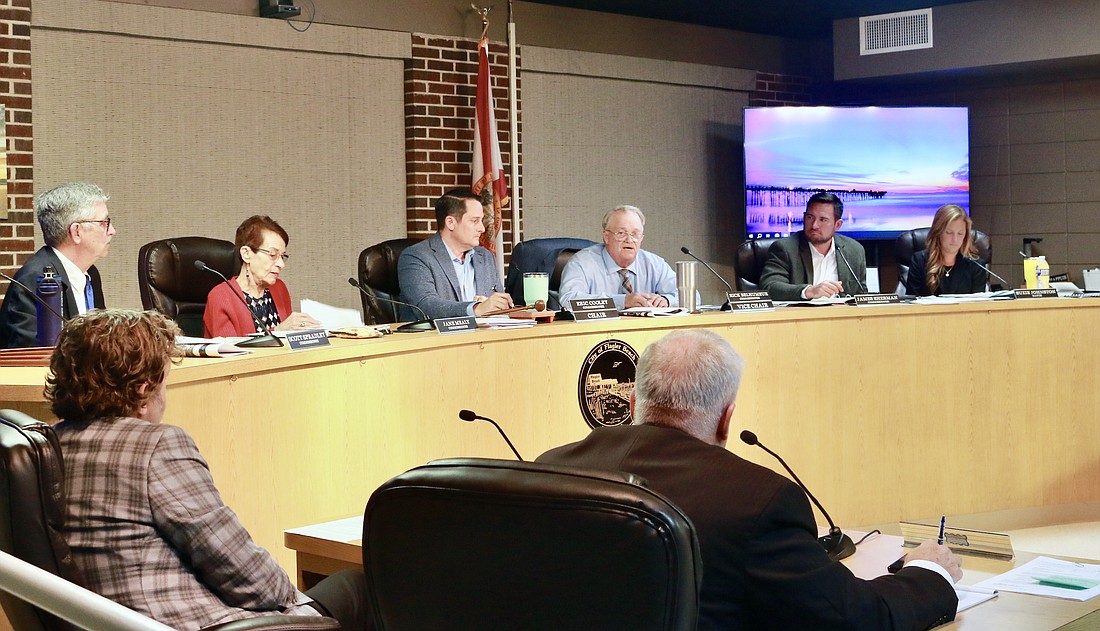- December 13, 2025

As the end of Flagler Beach’s 180-day moratorium on new building applications exceeding the city’s 35-foot height maximum creeps forward, the City Commission is looking to clean up the ordinance’s definitions and review some of the exceptions listed.
The moratorium, implemented Nov. 9, expires in May. The Flagler Beach Planning and Architectural Review Board will review the city’s height ordinance — and its exceptions, which allow qualifying builds an extra 14 feet — on April 2. Commission Chair Eric Cooley said the city needs to specifically add in clear definitions for the exceptions and examine the 14-foot extension for them.
“The number one concern is when is a tower not a tower,” Cooley said, using tower as a specific example in the list of exceptions. “…We need to define what a tower is because what’s happening is a ‘tower’ is not defined, so you can essentially call anything a tower.”
The ordinance limits buildings to 35 feet in height, with exceptions for “chimneys, cooling towers, elevators, bulkheads, fire towers, gas tanks, steeples, water towers, ornamental towers or spires, communications, radio or television towers or necessary mechanical appurtenances.” The exceptions cannot exceed 40% of the 35-foot maximum, which breaks down to a maximum of an additional 14 feet, and cannot be used as livable space.
The moratorium was implemented after conversations last fall of what qualified as certain exemptions. Cooley said he wants to be clear of what qualifies to prevent the exceptions from being used to build higher buildings.
“When does an architectural element become part of the structure,” he said, “and you’re just wanting to build a 49-foot structure?”
City Manager Dale Martin said any review of the ordinance will not include any consideration to raising the height maximum.
“There is no support to change the height of 35 feet,” Martin said.
Commissioners Rick Belhumeur and Jane Mealy were in favor of leaving the ordinance and exceptions alone. Mealy did say she was unsure some of the items were necessary exceptions, but even then, she said, “none of this is getting anywhere near 49 feet.”
Commissioner Scott Spradley said he is looking forward to hearing more information from professionals in the industry. He said there does seem to be some room for adjustments in the ordinance.
“The 40% seems a little high but I'm open to making some adjustments, just not 35 (feet) for everything,” Spradley said.
Cooley said he agreed that the 40% was probably too high.
PAR Board Member Joseph Joseph Pozzuoli said he thinks it would be pretty simple to add definitions to those terms, but cautioned the commission about changes to the 40% exception allowance.
As an architect, he said, he knows proportion and scale are key to quality architecture.
“Proportion and scale is going to be what make your quaint town stay a quaint town,” Pozzuoli said. “It’s going to make your buildings high quality.”
The hotel being 47 feet at the highest part, balances the proportion of the building, he said. Instead of necessarily changing the code, he said, he would like to see the city’s new planner work with the PAR Board to ensure exceptions are high quality, good architecture.
“We try to look at proportion and scale,” Pozzuoli said.
There are also other considerations, he said, like required service elevators for some mechanical components, as well as certain safety considerations. It’s important to understand that architecture is more than just structure, he said.
“It’s multifaceted and our proportion and scale is important,” Pozzuoli said. “There are reasons we architects do this.”